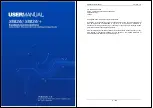
14: User Authentication
EMG™ Edge Management Gateway User Guide
311
2. Enter the following:
Enable Kerberos
Check box displays as checked if this method is enabled on the User
Authentication page. If you want to set up this authentication method but not enable
it immediately, clear the checkbox.
Note:
You can enable Kerberos here or on the first User Authentication page. If
you enable Kerberos here, it automatically displays at the end of the order of
precedence on the User Authentication page.
Realm
Enter the name of the logical network served by a single Kerberos database and a
set of Key Distribution Centers. Usually, realm names are all uppercase letters to
differentiate the realm from the Internet domain. Realm is similar in concept to an
NT domain.
KDC
A key distribution center (KDC) is a server that issues Kerberos tickets. A ticket is a
temporary set of electronic credentials that verify the identity of a client for a
particular service.
Enter the
KDC
in the fully qualified domain format (FQDN). An example is
emg.local.
KDC IP Address
Enter the IPv4 or IPv6 address of the Key Distribution Center (KDC).
KDC Port
Port on the KDC listening for requests. Enter an integer with a maximum value of
65535. The default is
88
.
Use LDAP
Indicate whether Kerberos should rely on LDAP to look up
user IDs and Group IDs. This setting is disabled by default.
Note:
Make sure to configure LDAP if you select this option.
Custom Menu
If custom menus have been created, you can assign a default custom menu to
RADIUS users.
Escape Sequence
A single character or a two-character sequence that causes the EMG to leave
direct (interactive) mode. (To leave listen mode, press any key.)
A suggested value is
Esc+A
(escape key, then uppercase "A" performed quickly
but not simultaneously). You would specify this value as
\
x1bA
, which is
hexadecimal (
\
x
) character 27 (
1B
) followed by an
A
.
This setting allows the user to terminate the
connect direct
command on the
command line interface when the endpoint of the command is
deviceport
,
tcp
, or
udp
.
for notes on key sequence precedence and
behavior.
Break Sequence
A series of 1-10 characters users can enter on the command line interface to send
a break signal to the external device. A suggested value is
Esc+B
(escape key,
then uppercase “B” performed quickly but not simultaneously). You would specify
this value as
\
x1bB
, which is hexadecimal (
\
x
) character 27 (
1B
) followed by a
B
.
Enable for Dial-back
Select to grant a user dial-back access. Users with dial-back access can dial into
the EMG and enter their login and password. Once the EMG unit authenticates
them, the modem hangs up and dials them back. Disabled by default.
Dial-back Number
The phone number the modem dials back on depends on this setting for the device
port. The user is either dialed back on a fixed number, or on a number that is
associated with the user’s login (specified here).
Data Ports
The ports users are able to monitor and interact with using the connect direct
command.
U1
denotes the USB port on the front of the EMG unit.
Listen Port
The ports users are able to monitor using the
connect listen
command.
Clear Port Buffers
The ports whose port buffer users may clear using the
set locallog clear
command.
Summary of Contents for EMG Series
Page 100: ...7 Networking EMG Edge Management Gateway User Guide 100 Figure 7 5 Network Wireless Settings...
Page 353: ...15 Maintenance EMG Edge Management Gateway User Guide 353 Figure 15 12 About EMG...
Page 474: ...EMG Edge Management Gateway User Guide 474 Figure E 3 EU Declaration of Conformity...
Page 475: ...EMG Edge Management Gateway User Guide 475 Figure E 4 EU Declaration of Conformity continued...
















































